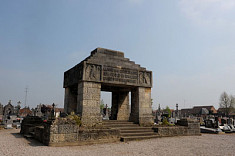Contents
German authorities
In the occupied territories all the powers which would normally be enjoyed by the French state were transferred to the German Army, with ultimate authority held by its General Headquarters. German HQ was initially set up in Luxemburg before moving to Charleville and Spa, and there was also a command post in Avesnes-sur-Helpe. Every army general in charge of a specific body of German servicemen had a corresponding military governor who reigned over the civilian population.
Towns and villages were grouped together under the control of a command post called a Kommandatur which was generally set up in the traditional administrative centre of a district. If it was close to the front it was called an Orstkommandantur, if not, it was an Etappenkommandantur. Each Kommandatur was headed by a commander, usually a military officer, who was assisted by an inspecting officer, in charge of requisitioning and searches, and a land officer called a Landwache. In most cases the Kommandaturen were manned by a large staff of six to eight men, initially soldiers but these were gradually replaced by German civilians.
Kommandanturen were generally housed in public buildings but sometimes the German Army commandeered private dwellings and evicted their owners. In the case of Lille the town was run by a general and a deputy general. In Valenciennes and Saint-Amand the local governor was a colonel assisted by an army captain. In 1917 Avesnes-sur-Helpe had a colonel for governor, assisted by a lieutenant, and a staff of twenty-one non-commissioned officers and various civil servants who ran the hospitals, shops and business committees.
Civil order was maintained by military police and each Kommandantur was allocated a few gendarmes led by a non-commissioned officer to police the roads, carry out requisitioning, investigate fraud and generally monitor the population. In urban areas soldiers who were unfit for duty on the front assisted the military police, while in the country military reserves policed the fields. Offenders were sent before a judge (normally a professional civil servant) presiding over a police court, or Polizeiamt, which was also the place where the many fines doled out during the occupation had to be paid.
Quartering
Officers and troops were usually lodged in local people's homes and were required to provide the host with a "billet", a sort of housing voucher. Officers were quartered in the more beautiful residences while private soldiers had the choice of plainer accommodation. The best rooms in the house were reserved for the German occupiers, the kitchen was shared. In the early days of the occupation the hosts were required to feed their guests but this system was soon abandoned in the face of increasing shortages. The owners of some buildings were evicted to make way for high-ranking officers and their staff (for example, Crown Prince Rupert of Bavaria set up home in the mansion of Dr Dubar in avenue Salomon, Lille). At the beginning of 1918 the German GHQ moved from the town of Spa (Belgium) to Avesnes-sur-Helpe in readiness for the German Spring Offensive. Emperor William II took up residence in the stately home Château de Mérode in Trélon, General Hindendurg moved into the sub-prefect's residence in Avesnes, and General Ludendorff and his staff requisitioned housing in Dourlers, Dompierre and Saint-Hilaire. In the warmer months William II moved to Château Dubois in the town of Avesnes (on the road to Landrecies). Schools and colleges were often requisitioned which could only disrupt schooling, especially when teachers were drafted into active service or required for fatigues.
French authorities
The French administration continued to function during the occupation but its powers were severely restricted. The Prefect of the Nord Department, Félix Trépont, kept his position in 1914 however the following year he was arrested, deported to Germany and then repatriated to Dunkirk whereupon he was returned to his post as prefect and remained in office until September 1918! During his detention in Germany the sub-prefect of Avesnes-sur-Helpe was designated by the Germans to carry out his official duties.
Elected mayors also saw their powers increased. Freed from prefectorial supervision Charles Delesalle, mayor of Lille, managed to reach a working agreement with the occupiers and, while demonstrating his loyalty to the Germans, endeavoured to ensure that the Hague Conventions were respected. Adopted in 1899 and amended in 1907, the Hague Convention respecting the Laws and Customs of War on Land imposed various obligations on a military authority in its administration of an occupied territory. After the war Charles Delesalle was criticized for his lack of "pugnacity".
A publication called Le Bulletin de Lille was distributed by Lille town council under German supervision, its director being one Paul Cornil. It was a small newspaper, printed recto verso, which appeared twice a week (Sundays and Thursdays) from 15 November 1914 onwards. In addition to official information and German decrees, the paper also contained advertisements, announcements (births, marriages, deaths and so on), practical advice on health and nutrition and even recipes and poems.
Claudine WALLART, Head Curator of Heritage
at the Archives Départementales du Nord (Nord Records Office)




